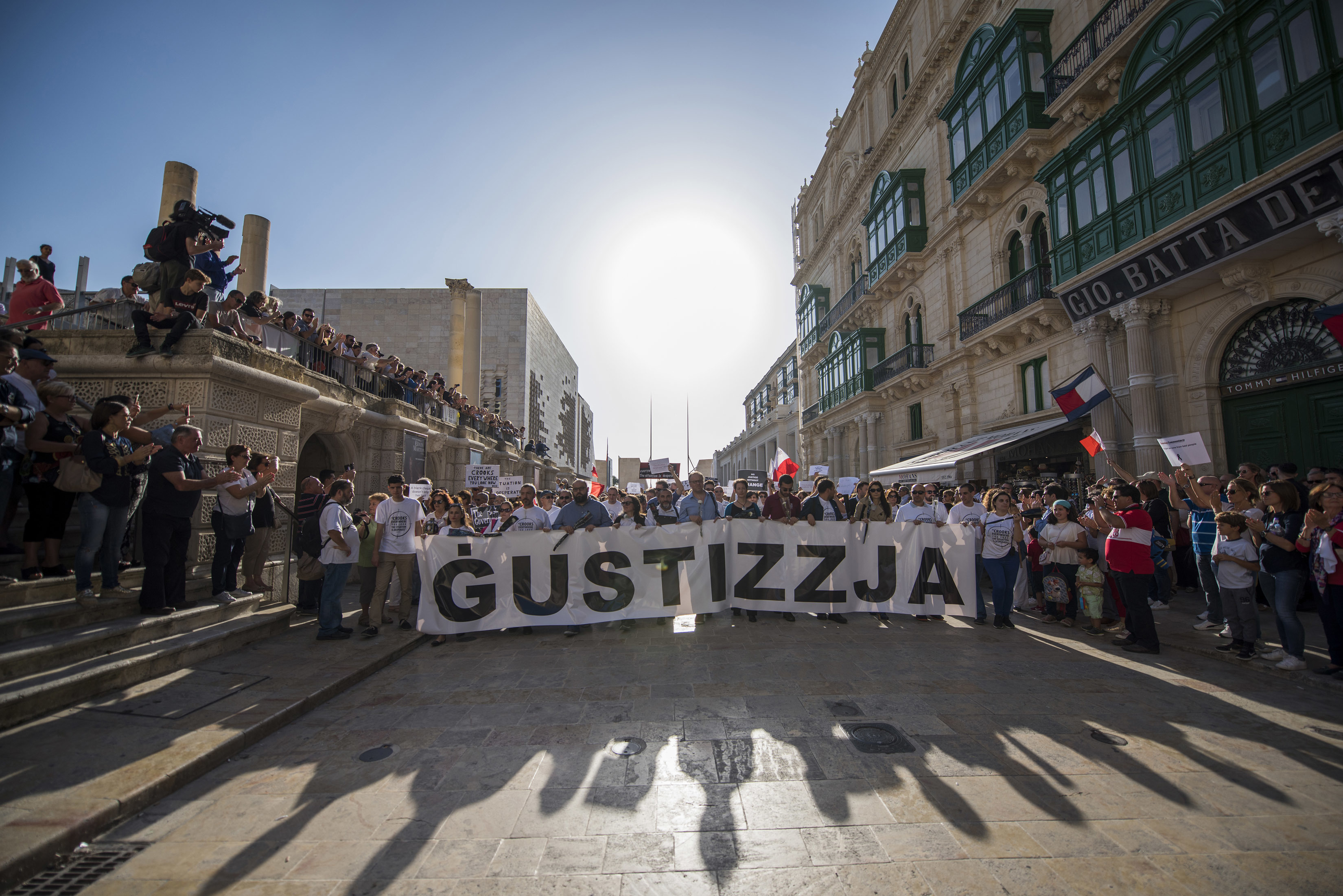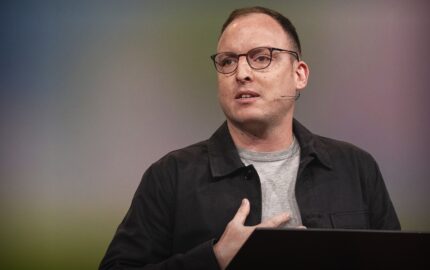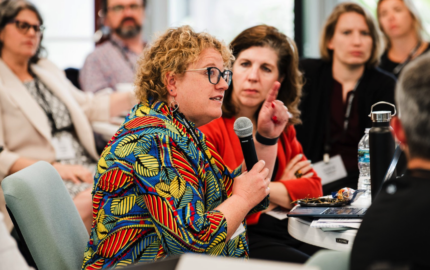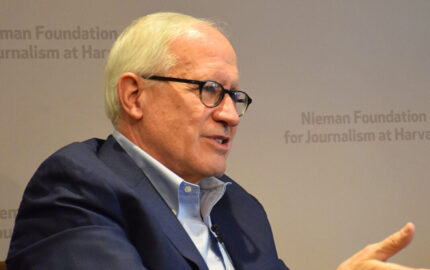A French investigative journalist and filmmaker, Laurent Richard is the co-founder of the popular French public television newsmagazine “Cash Investigation,” produced by Premières Lignes. He has also produced several long-form investigative stories for television and oversaw coverage of LuxLeaks—the tax evasion scandal in Luxembourg that “Cash Investigation” uncovered in 2012. Subsequently, the International Consortium of Investigative Journalists expanded on the investigation.
Richard made headlines last year when he and reporter Elise Lucet, presenter of “Cash Investigation,” were sued by Azerbaijan for describing the country as a dictatorship on their program; it was the first time in history that a foreign government brought a defamation suit against French journalists on their own soil. The French court last November rejected the case against Richard and Lucet.
A 2017 Knight-Wallace fellow at the University of Michigan, Richard is also the founder and executive director of the nonprofit investigative newsroom Freedom Voices Network. Last November, the network officially launched Forbidden Stories, a project dedicated to protecting and continuing the work of journalists who may be threatened, imprisoned, or killed. The project, which received the “journalism project of the year” grand prize at the French Annual Journalism Summit in March, was modeled after the Arizona Project, in which a number of investigative reporters from around the country joined together in 1976 to finish the work of slain Arizona Republic reporter Don Bolles. On their first collaborative effort, which was published in April, Forbidden Stories worked with nearly 20 news organizations and more than 40 journalists—pouring over 750,000 documents over the course of 5 months—to complete the stories of Maltese investigative journalist Daphne Caruana Galizia, who was assassinated in a car bombing last fall.
Richard visited the Nieman Foundation in March to discuss the project. Edited excerpts:
There are lots of very good organizations protecting journalists themselves, like Reporters Without Borders and the Committee to Protect Journalists. The main idea of Forbidden Stories is not to physically protect journalists, it’s to protect the stories of journalists. We want to keep the stories alive because when journalists get killed, arrested, or threatened, it’s often because of the story they want to publish.
At the same time, we want to help at‑risk journalists protect their stories while they are investigating. The idea is, in Paris, in New York, before you send reporters into very dangerous situations, you have that conversation: “If I don’t hear from you in the next five hours, what will we do? Give me a list of the people to contact in case of emergency.” We want to help at‑risk journalists protect their work. Using encrypted communication channels, they can send us some piece or important aspect of their ongoing stories; they can use secret drop systems, the Signal messenger application, or PGP emails if they want to communicate with us.
This idea actually is not new. There was the Arizona Project, an American collaboration between something like 30 journalists in the United States who decided in 1976 to complete the stories of the American reporter Don Bolles, who died in a car explosion in Phoenix, Arizona. The stories were about corruption and money laundering.
There was also a similar collaboration called the Khadija Project, named after Khadija Ismayilova, a well‑known investigative reporter in Azerbaijan. In 2014, she was charged with tax evasion and embezzlement and sentenced to seven-plus years in prison; it was considered by many to be revenge for her investigations into corruption among President Ilham Aliyev and his family. She was released on probation in 2016 after her imprisonment was widely criticized by human rights organizations. While she was in prison, colleagues and friends joined together to continue doing her work.
I know her quite well because I’ve done investigative work myself in Azerbaijan. I’ve been arrested there, but because I was French, I only stayed a few hours with the intelligence services before being sent back to France.
When Khadija was in jail, I received a letter from her asking me about the status of my documentary examining corruption between the Azerbaijan state and Council of Europe representatives. She was asking me, “Where are you with your investigation? It is important, Laurent, to keep investigating that.”
We broadcast the two-hour documentary on a prime‑time French public television program. That was when I started thinking that we should organize a platform, a collaborative project, devoted to keeping stories alive after the journalists working on them have been killed or jailed.
I had a personal reason, too, for starting Forbidden Stories. I was living in Paris and working in an office on the same floor as the Charlie Hebdo newsroom. On January 7, 2015, two terrorists came into the building and killed a lot of my colleagues. I used to go frequently into conflict zones, but this time the violence was happening in the middle of Paris. I arrived about 2 minutes after the terrorists left the building. With some of my colleagues, I spent the next hour trying to help the people who survived and trying to identify the people who were dead. It was a traumatic experience for me and for my colleagues at Premières Lignes.
To those who are threatening journalists, we say that if you want to harm them, then you should expect that their story will still be broadcast or published, not just in one country but in 10 or 20 countries, and you will have to answer to 10 or 20 journalists who will ask you questions about corruption, money laundering, impunity, the assassination investigation, or whatever the subject of the story may be.
I think they will then think twice before doing any kind of harm. The Streisand effect—in which an attempt to hide a piece of information has the unintended consequence of publicizing the information more widely—is the DNA of our platform.
For now we have only two full-time staff members who are paid thanks to a grant from the Omidyar Network. The International Consortium of Investigative Journalists is working with hundreds of publishing news organizations all around the world. The Organized Crime and Corruption Reporting Project is doing the same. We are very small compared to those organizations, and we are on a very specific mission of continuing the stories journalists can no longer continue.
We need supporters committed to tackling censorship and interested in complicated stories. We are very open to working with other large news organizations. The idea of continuing the stories of journalists is not very new, but with the spirit of collaboration and with the technology now available, we can do a lot more. I think collaboration is really our best protection.
Our website will likely be censored in some countries. That’s why we are broadcasting also on social networks. Sometimes these social networks will be censored in certain countries, like Turkey, for example.
We plan to partner with organizations that will help us to publish on mirror sites, so when you shut down one site, you open another site. We don’t want to endanger the people we are talking to so that’s why we are relying on three open source technologies—Signal, PGP, and SecureDrop. We are hosting the data not only in one place but in many places.
Richard made headlines last year when he and reporter Elise Lucet, presenter of “Cash Investigation,” were sued by Azerbaijan for describing the country as a dictatorship on their program; it was the first time in history that a foreign government brought a defamation suit against French journalists on their own soil. The French court last November rejected the case against Richard and Lucet.
A 2017 Knight-Wallace fellow at the University of Michigan, Richard is also the founder and executive director of the nonprofit investigative newsroom Freedom Voices Network. Last November, the network officially launched Forbidden Stories, a project dedicated to protecting and continuing the work of journalists who may be threatened, imprisoned, or killed. The project, which received the “journalism project of the year” grand prize at the French Annual Journalism Summit in March, was modeled after the Arizona Project, in which a number of investigative reporters from around the country joined together in 1976 to finish the work of slain Arizona Republic reporter Don Bolles. On their first collaborative effort, which was published in April, Forbidden Stories worked with nearly 20 news organizations and more than 40 journalists—pouring over 750,000 documents over the course of 5 months—to complete the stories of Maltese investigative journalist Daphne Caruana Galizia, who was assassinated in a car bombing last fall.
Richard visited the Nieman Foundation in March to discuss the project. Edited excerpts:
On the mission of Forbidden Stories
There are lots of very good organizations protecting journalists themselves, like Reporters Without Borders and the Committee to Protect Journalists. The main idea of Forbidden Stories is not to physically protect journalists, it’s to protect the stories of journalists. We want to keep the stories alive because when journalists get killed, arrested, or threatened, it’s often because of the story they want to publish.
At the same time, we want to help at‑risk journalists protect their stories while they are investigating. The idea is, in Paris, in New York, before you send reporters into very dangerous situations, you have that conversation: “If I don’t hear from you in the next five hours, what will we do? Give me a list of the people to contact in case of emergency.” We want to help at‑risk journalists protect their work. Using encrypted communication channels, they can send us some piece or important aspect of their ongoing stories; they can use secret drop systems, the Signal messenger application, or PGP emails if they want to communicate with us.
On drawing inspiration from the Arizona Project and Khadija Ismayilova
This idea actually is not new. There was the Arizona Project, an American collaboration between something like 30 journalists in the United States who decided in 1976 to complete the stories of the American reporter Don Bolles, who died in a car explosion in Phoenix, Arizona. The stories were about corruption and money laundering.
There was also a similar collaboration called the Khadija Project, named after Khadija Ismayilova, a well‑known investigative reporter in Azerbaijan. In 2014, she was charged with tax evasion and embezzlement and sentenced to seven-plus years in prison; it was considered by many to be revenge for her investigations into corruption among President Ilham Aliyev and his family. She was released on probation in 2016 after her imprisonment was widely criticized by human rights organizations. While she was in prison, colleagues and friends joined together to continue doing her work.
I know her quite well because I’ve done investigative work myself in Azerbaijan. I’ve been arrested there, but because I was French, I only stayed a few hours with the intelligence services before being sent back to France.
When Khadija was in jail, I received a letter from her asking me about the status of my documentary examining corruption between the Azerbaijan state and Council of Europe representatives. She was asking me, “Where are you with your investigation? It is important, Laurent, to keep investigating that.”
We broadcast the two-hour documentary on a prime‑time French public television program. That was when I started thinking that we should organize a platform, a collaborative project, devoted to keeping stories alive after the journalists working on them have been killed or jailed.
On how the Charlie Hebdo attack impacted the project
I had a personal reason, too, for starting Forbidden Stories. I was living in Paris and working in an office on the same floor as the Charlie Hebdo newsroom. On January 7, 2015, two terrorists came into the building and killed a lot of my colleagues. I used to go frequently into conflict zones, but this time the violence was happening in the middle of Paris. I arrived about 2 minutes after the terrorists left the building. With some of my colleagues, I spent the next hour trying to help the people who survived and trying to identify the people who were dead. It was a traumatic experience for me and for my colleagues at Premières Lignes.
On the message Forbidden Stories sends
To those who are threatening journalists, we say that if you want to harm them, then you should expect that their story will still be broadcast or published, not just in one country but in 10 or 20 countries, and you will have to answer to 10 or 20 journalists who will ask you questions about corruption, money laundering, impunity, the assassination investigation, or whatever the subject of the story may be.
I think they will then think twice before doing any kind of harm. The Streisand effect—in which an attempt to hide a piece of information has the unintended consequence of publicizing the information more widely—is the DNA of our platform.
On the importance of collaboration
For now we have only two full-time staff members who are paid thanks to a grant from the Omidyar Network. The International Consortium of Investigative Journalists is working with hundreds of publishing news organizations all around the world. The Organized Crime and Corruption Reporting Project is doing the same. We are very small compared to those organizations, and we are on a very specific mission of continuing the stories journalists can no longer continue.
We need supporters committed to tackling censorship and interested in complicated stories. We are very open to working with other large news organizations. The idea of continuing the stories of journalists is not very new, but with the spirit of collaboration and with the technology now available, we can do a lot more. I think collaboration is really our best protection.
On circumventing censorship
Our website will likely be censored in some countries. That’s why we are broadcasting also on social networks. Sometimes these social networks will be censored in certain countries, like Turkey, for example.
We plan to partner with organizations that will help us to publish on mirror sites, so when you shut down one site, you open another site. We don’t want to endanger the people we are talking to so that’s why we are relying on three open source technologies—Signal, PGP, and SecureDrop. We are hosting the data not only in one place but in many places.



